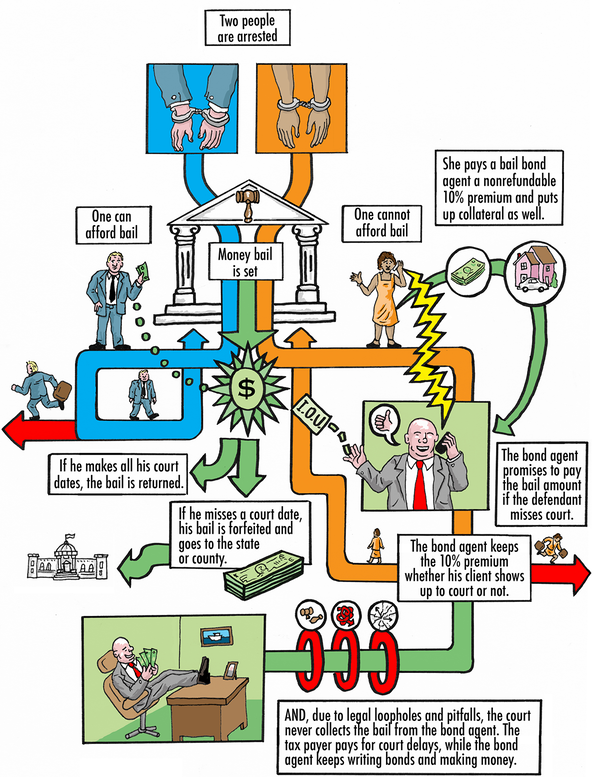
The American legal system relies heavily on the concept of bail, a complex mechanism that plays a crucial role in navigating the pre-trial process. At its core, bail aims to balance the rights of defendants with the need for public safety and court appearances. Understanding how bail systems function and their implications is essential for comprehending the complexities of our justice system. This article will delve into the intricacies of bail, exploring its purpose, types, and the profound impact it has on individuals awaiting trial.
This comprehensive guide will first define what bail entails and then dissect the mechanics of how bail systems operate in practice. We’ll examine the multifaceted reasons behind the existence of bail and explore the various forms it can take. Furthermore, we’ll analyze the significant consequences that bail can have on defendants, both positive and negative. Finally, we’ll conclude by summarizing the key takeaways regarding bail and its enduring influence on the legal landscape.
What is Bail?
In essence, bail refers to a sum of money or other form of security pledged by a defendant to a court as a guarantee that they will appear for all scheduled hearings and proceedings related to their case. This financial commitment serves as an incentive for defendants to comply with court orders and avoid absconding before trial. If the defendant fulfills their obligations, the bail is returned in full. However, if they fail to appear, the court can forfeit the bail amount.
Bail is typically set by a judge based on several factors, including the severity of the alleged offense, the defendant’s criminal history, and their ties to the community. The goal is to strike a balance between ensuring court appearances and protecting public safety. While some defendants may be able to afford to pay bail outright, others may require assistance from family, friends, or professional bail bondsmen.
How Bail Systems Work
The process of securing bail involves several steps. Initially, after an arrest, the defendant is brought before a judge for an arraignment hearing. During this hearing, the judge determines the appropriate bail amount based on the aforementioned factors. The defendant can then choose to pay the full bail amount directly to the court or seek assistance from a bail bondsman.
A bail bondsman is a licensed professional who acts as a guarantor for the defendant’s appearance in court. In exchange for a non-refundable fee, typically 10% of the total bail amount, the bondsman agrees to pay the full bail sum to the court if the defendant fails to appear. This arrangement allows defendants who cannot afford to pay the full bail amount to be released from custody while awaiting trial.
Purpose of Bail
The existence of why do bails exist is rooted in several key objectives:
- Ensuring Court Appearances: The primary purpose of bail is to incentivize defendants to attend all scheduled court hearings and proceedings. By requiring a financial guarantee, the system aims to deter defendants from fleeing prosecution and avoiding legal responsibility.
Protecting Public Safety: Bail can also serve as a tool for protecting public safety by keeping potentially dangerous individuals in custody while awaiting trial. In cases involving serious offenses or concerns about flight risk, judges may set higher bail amounts or deny bail altogether.
Presumption of Innocence: The concept of bail aligns with the fundamental principle of “innocent until proven guilty.” By allowing defendants to remain free on bail pending trial, the system acknowledges their presumption of innocence and avoids pre-trial detention solely based on accusations.
Types of Bail
Bail can take various forms depending on the circumstances of the case and the defendant’s financial situation:
- Cash Bail: This involves paying the full bail amount directly to the court in cash. Once the defendant fulfills their court obligations, the cash is returned.
- Surety Bail: In this scenario, a third party, typically a licensed bail bondsman, posts the full bail amount on behalf of the defendant. The bondsman charges a non-refundable fee, usually 10% of the total bail amount, and assumes financial responsibility if the defendant fails to appear in court.
- Property Bail: This type of bail involves using real estate or other valuable assets as collateral to secure release. If the defendant fails to appear, the court can seize the property to cover the bail amount.
The Impact of Bail on Defendants
The impact of bail on defendants can be multifaceted and far-reaching:
- Financial Burden: For many defendants, particularly those with limited financial resources, posting bail can pose a significant financial burden. This can lead to job loss, eviction, or other hardships that further complicate their legal situation.
Pre-Trial Detention: If a defendant cannot afford bail, they may be held in pre-trial detention until their trial date. This can have detrimental effects on their mental and physical well-being, as well as their ability to prepare for their defense.
Disproportionate Impact: Studies have shown that why do bails exist disproportionately affect marginalized communities, exacerbating existing inequalities within the justice system. Factors such as poverty, lack of access to legal representation, and systemic biases can contribute to higher bail amounts and increased pre-trial detention for individuals from these communities.
Conclusion
Bail systems are a complex and often controversial aspect of the American legal landscape. While they serve important purposes in ensuring court appearances and protecting public safety, their implementation can have significant consequences for defendants, particularly those with limited financial resources. Understanding the intricacies of why do bails exist, their various types, and their impact on individuals is crucial for fostering a more equitable and just legal system.
